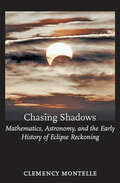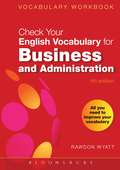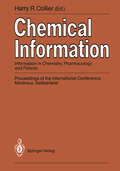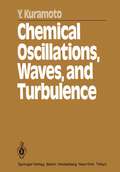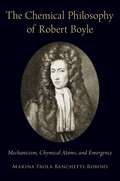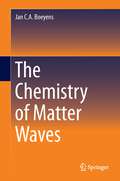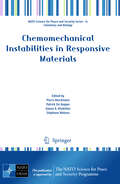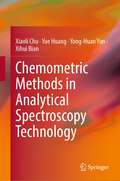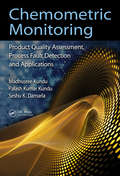- Table View
- List View
Chases and Escapes: The Mathematics of Pursuit and Evasion (PDF)
by Paul J. NahinWe all played tag when we were kids. What most of us don't realize is that this simple chase game is in fact an application of pursuit theory, and that the same principles of games like tag, dodgeball, and hide-and-seek are also at play in military strategy, high-seas chases by the Coast Guard, and even romantic pursuits. In Chases and Escapes, Paul Nahin gives us the first complete history of this fascinating area of mathematics, from its classical analytical beginnings to the present day. Drawing on game theory, geometry, linear algebra, target-tracking algorithms, and much more, Nahin also offers an array of challenging puzzles with their historical background and broader applications. Chases and Escapes includes solutions to all problems and provides computer programs that readers can use for their own cutting-edge analysis. Now with a gripping new preface on how the Enola Gay escaped the shock wave from the atomic bomb dropped on Hiroshima, this book will appeal to anyone interested in the mathematics that underlie pursuit and evasion.
Chasing Shadows: Mathematics, Astronomy, and the Early History of Eclipse Reckoning (Johns Hopkins Studies in the History of Mathematics)
by Clemency MontelleLunar and solar eclipses have always fascinated human beings. Digging deep into history, Clemency Montelle examines the ways in which theoretical understanding of eclipses originated and how ancient and medieval cultures shared, developed, and preserved their knowledge of these awe-inspiring events.Eclipses were the celestial phenomena most challenging to understand in the ancient world. Montelle draws on original research—much of it derived from reading primary source material written in Akkadian and Sanskrit, as well as ancient Greek, Latin, and Arabic—to explore how observers in Babylon, the Islamic Near East, Greece, and India developed new astronomical and mathematical techniques to predict and describe the features of eclipses. She identifies the profound scientific discoveries of these four cultures and discusses how the societies exchanged information about eclipses. In constructing this history, Montelle establishes a clear pattern of the transmission of scientific ideas from one culture to another in the ancient and medieval world. Chasing Shadows is an invitingly written and highly informative exploration of the early history of astronomy.
Chasles and the Projective Geometry: The Birth of a Global Foundational Programme for Mathematics, Mechanics and Philosophy
by Paolo BussottiThis monograph meticulously examines the contributions of French mathematician Michel Chasles to 19th-century geometry. Through an in-depth analysis of Chasles' extensive body of work, the author examines six pivotal arguments which collectively reshape the foundations of geometry. Chasles introduces a novel form of polarity, termed "parabolic," to the graphic context, so expressing the metric properties by means of this specific polarity—a foundational argument. Beyond the celebrated "Chasles theorem," he extends his analysis to the movement of a rigid body, employing concepts derived from projective geometry. This approach is consistently applied across diverse domains. Chasles employs the same methodology to analyze systems of forces. The fourth argument examined by the author concerns the principle of virtual velocities, which can also be addressed through a geometric analysis. In the fifth chapter, Chasles' philosophy of duality is explained. It is grounded on theduality principles of projective geometry. Finally, the author presents Chasles’ synthetic solution for the intricate problem of ellipsoid attraction—the sixth and concluding chapter. Throughout these explorations, Chasles engages in a dynamic scientific dialogue with leading physicists and mathematicians of his era, revealing diverse perspectives and nuances inherent in these discussions.Tailored for historians specializing in mathematics and geometry, this monograph also beckons philosophers of mathematics and science, offering profound insights into the philosophical, epistemological, and methodological dimensions of Chasles' groundbreaking contributions. Providing a comprehensive understanding of Chasles' distinctive perspective on 19th-century geometry, this work stands as a valuable resource for scholars and enthusiasts alike.
Chebyshev Splines and Kolmogorov Inequalities (Operator Theory: Advances and Applications #105)
by Sergey BagdasarovCheck Your English Vocabulary for Business and Administration: All you need to improve your vocabulary (Check Your Vocabulary)
by Rawdon WyattThis workbook provides a range of exercises to help learners of English at intermediate level and above learn and review essential vocabulary used in business and administration. It is particularly suitable for students or overseas-trained business and administration staff who want to work in an English-speaking country, or whose work brings them into regular contact with English-speaking business people. It is also ideal for students who are planning to take the BEC Vantage / Higher exam, the TOEIC or one of the LCCI International Qualifications.
Chemical and Bioprocess Engineering: Fundamental Concepts for First-Year Students
by Ricardo Simpson Sudhir K. SastryThe goal of this textbook is to provide first-year engineering students with a firm grounding in the fundamentals of chemical and bioprocess engineering. However, instead of being a general overview of the two topics, Fundamentals of Chemical and Bioprocess Engineering will identify and focus on specific areas in which attaining a solid competency is desired. This strategy is the direct result of studies showing that broad-based courses at the freshman level often leave students grappling with a lot of material, which results in a low rate of retention. Specifically, strong emphasis will be placed on the topic of material balances, with the intent that students exiting a course based upon this textbook will be significantly higher on Bloom’s Taxonomy (knowledge, comprehension, application, analysis and synthesis, evaluation, creation) relating to material balances. In addition, this book also provides students with a highly developed ability to analyze problems from the material balances perspective, which leaves them with important skills for the future. The textbook consists of numerous exercises and their solutions. Problems are classified by their level of difficulty. Each chapter has references and selected web pages to vividly illustrate each example. In addition, to engage students and increase their comprehension and rate of retention, many examples involve real-world situations.
Chemical Calculations: Mathematics for Chemistry, Second Edition
by Paul YatesMany undergraduate students enter into chemistry courses from a wide range of backgrounds, often possessing various levels of experience with the mathematical concepts necessary for carrying out practical calculations in chemistry. Chemical Calculations: Mathematics for Chemistry, Second Edition provides a unified, student-friendly reference
Chemical Evolution: Proceedings of the Fourth Trieste Conference on Chemical Evolution, Trieste, Italy, 4–8 September 1995
by Julian Chela-Flores François RaulinLeading researchers in the area of the origin and evolution of life in the universe contributed to Chemical Evolution: Physics of the Origin and Evolution of Life. This volume provides a review of this interdisciplinary field. In 35 chapters many aspects of the origin of life are discussed by 90 authors, with particular emphasis on the early paleontological record: physical, chemical, biological, and informational aspects of life's origin, instrumentation in exobiology and system exploration; the search for habitable planets and extraterrestrial intelligent radio signals. This book contains the proceedings of the Fourth Trieste Conference on Chemical Evolution that took place in September 1995, in which scientists from a wide geographical distribution joined in a Memorial to Cyril Ponnamperuma, who was a pioneer in the field of chemical evolution, the origin of life, and exobiology, and also initiated the Trieste Conferences on Chemical Evolution and the Origin of Life. This fourth Conference was therefore dedicated to his memory. Audience: Graduate students and researchers in the many areas of basic, earth, and life sciences that contribute to the study of chemical evolution and the origin of life.
Chemical Information: Information in Chemistry, Pharmacology and Patents Proceedings of the International Conference, Montreux, Switzerland, September 1989
by Harry R. CollierThis volume contains the full text of twenty-six of the thirty-one papers given at the Montreux 1989 International Chemical Information Conference in Montreux, Switzerland between 26 and 28 September 1989. The five papers omitted were due to their late completion and subsequent unavailability for incorporation in this volume. Of the twenty-six papers included, all but three were delivered to Infonortics in diskette form between 1 July and 1 August 1989; by 17 August 1989 the 310 pages of text and figures were typeset and scanned graphics inserted. By 26 September 1989 all copies were printed in England and delivered to the Montreux Congress Centre in Switzerland. The rapid and efficient process reflects creditably on all parties concerned, especially on the authors who followed assiduously the detailed instructions concerning presentation they were given. Conventional publishing is not so rapid, but conventional publishing does give time for authors to proof-read their texts, make correc tions and add material, and gives time for the publisher to index the work thoroughly and completely. The current Proceedings have not been proof-read by the authors, nor is there an index. I hope that readers will appreciate this trade-off between currency and thoroughness and will recognise some of the limitations imposed by publishing proceedings at the same time the conference is held. H.R. Collier Infonortics Ltd., August 1989 Caine, Wiltshire, England v Table of Contents Chemical information as a commercial marketplace E. Garfield ..•.•.•••..........•.•...•............•.•...•.
Chemical Kinetics, Stochastic Processes, and Irreversible Thermodynamics (Lecture Notes on Mathematical Modelling in the Life Sciences)
by Moisés SantillánThis book brings theories in nonlinear dynamics, stochastic processes, irreversible thermodynamics, physical chemistry and biochemistry together in an introductory but formal and comprehensive manner. Coupled with examples, the theories are developed stepwise, starting with the simplest concepts and building upon them into a more general framework. Furthermore, each new mathematical derivation is immediately applied to one or more biological systems. The last chapters focus on applying mathematical and physical techniques to study systems such as: gene regulatory networks and molecular motors.The target audience of this book are mainly final year undergraduate and graduate students with a solid mathematical background (physicists, mathematicians and engineers), as well as with basic notions of biochemistry and cellular biology. This book can also be useful to students with a biological background who are interested in mathematical modeling and have a working knowledge of calculus, differential equations and a basic understanding of probability theory.
Chemical Kinetics with Mathcad and Maple
by Viktor Korobov Valery OchkovThe authors explain at length the principles of chemical kinetics and approaches to computerized calculations in modern software suites — mathcad and maple. Mathematics is crucial in determining correlations in chemical processes and requires various numerical approaches. Often significant issues with mathematical formalizations of chemical problems arise and many kinetic problems can´t be solved without computers. Numerous problems encountered in solving kinetics´ calculations with detailed descriptions of the numerical tools are given. Special attention is given to electrochemical reactions, which fills a gap in existing texts not covering this topic in detail. The material demonstrates how these suites provide quick and precise behavior predictions for a system over time (for postulated mechanisms).Examples, i.e., oscillating and non-isothermal reactions, help explain the use of mathcad more efficiently. Also included are the results of authors’ own research toward effective computations.
Chemical Master Equation for Large Biological Networks: State-space Expansion Methods Using AI
by Don Kulasiri Rahul KosarwalThis book highlights the theory and practical applications of the chemical master equation (CME) approach for very large biochemical networks, which provides a powerful general framework for model building in a variety of biological networks. The aim of the book is to not only highlight advanced numerical solution methods for the CME, but also reveal their potential by means of practical examples. The case studies presented are mainly from biology; however, the applications from novel methods are discussed comprehensively, underlining the interdisciplinary approach in simulation and the potential of the chemical master equation approach for modelling bionetworks. The book is a valuable guide for researchers, graduate students, and professionals alike.
Chemical Oscillations, Waves, and Turbulence (Springer Series in Synergetics #19)
by Y. KuramotoTbis book is intended to provide a few asymptotic methods which can be applied to the dynamics of self-oscillating fields of the reaction-diffusion type and of some related systems. Such systems, forming cooperative fields of a large num of interacting similar subunits, are considered as typical synergetic systems. ber Because each local subunit itself represents an active dynamical system function ing only in far-from-equilibrium situations, the entire system is capable of showing a variety of curious pattern formations and turbulencelike behaviors quite unfamiliar in thermodynamic cooperative fields. I personally believe that the nonlinear dynamics, deterministic or statistical, of fields composed of similar active (Le., non-equilibrium) elements will form an extremely attractive branch of physics in the near future. For the study of non-equilibrium cooperative systems, some theoretical guid ing principle would be highly desirable. In this connection, this book pushes for ward a particular physical viewpoint based on the slaving principle. The dis covery of tbis principle in non-equilibrium phase transitions, especially in lasers, was due to Hermann Haken. The great utility of this concept will again be dem onstrated in tbis book for the fields of coupled nonlinear oscillators.
The Chemical Philosophy of Robert Boyle: Mechanicism, Chymical Atoms, and Emergence
by Marina Paola Banchetti-RobinoRobert Boyle (1627-1691) believed that a reductionist conception of the mechanical philosophy threatened the heuristic power and autonomy of chemistry as an experimental science. While some historical and philosophical scholars have examined his nuanced position, understanding the chemical philosophy he developed through his own experimental work is incredibly difficult even for experts in the field. In The Chemical Philosophy of Robert Boyle, Marina Paola Banchetti-Robino energetically explains Boyle's ideas in a whole new light and proposes that Boyle regarded chemical qualities as non-reducible dispositional and relational properties that emerge from, and supervene upon, the mechanistic structure of chymical atoms. Banchetti-Robino demonstrates that these ideas are implicit in Boyle's writing, making his philosophical contributions crucial to the fields of both philosophy and chemistry. The arguments presented are further strengthened by a detailed mereological analysis of Boylean chymical atoms as chemically elementary entities, which establishes the theory of wholes and parts that is most consistent with an emergentist conception of chemical properties. More generally, this book examines the way in which Boyle sought to accommodate his complex chemical philosophy within the framework of the 17th century mechanistic theory of matter. Banchetti-Robino conceptualizes Boyle's experimental work as a scientific research programme, in the Lakatosian sense, to better explain the positive and negative heuristic function of the mechanistic theory of matter within his chemical philosophy. The Chemical Philosophy of Robert Boyle actively engages with the contemporary and lively debates over the nature of Boyle's ideas about structural chemistry, fundamental mechanistic particles and properties, the explanatory power of subordinate causes, the complex relation between fundamental particles, natural kinds, and unified chemical wholes. The book is a rich historical account that begins with the dominant paradigms of 16th and 17th Century chemical philosophy and takes readers all the way through to the 21st Century.
The Chemical Philosophy of Robert Boyle: Mechanicism, Chymical Atoms, and Emergence
by Marina Paola Banchetti-RobinoRobert Boyle (1627-1691) believed that a reductionist conception of the mechanical philosophy threatened the heuristic power and autonomy of chemistry as an experimental science. While some historical and philosophical scholars have examined his nuanced position, understanding the chemical philosophy he developed through his own experimental work is incredibly difficult even for experts in the field. In The Chemical Philosophy of Robert Boyle, Marina Paola Banchetti-Robino energetically explains Boyle's ideas in a whole new light and proposes that Boyle regarded chemical qualities as non-reducible dispositional and relational properties that emerge from, and supervene upon, the mechanistic structure of chymical atoms. Banchetti-Robino demonstrates that these ideas are implicit in Boyle's writing, making his philosophical contributions crucial to the fields of both philosophy and chemistry. The arguments presented are further strengthened by a detailed mereological analysis of Boylean chymical atoms as chemically elementary entities, which establishes the theory of wholes and parts that is most consistent with an emergentist conception of chemical properties. More generally, this book examines the way in which Boyle sought to accommodate his complex chemical philosophy within the framework of the 17th century mechanistic theory of matter. Banchetti-Robino conceptualizes Boyle's experimental work as a scientific research programme, in the Lakatosian sense, to better explain the positive and negative heuristic function of the mechanistic theory of matter within his chemical philosophy. The Chemical Philosophy of Robert Boyle actively engages with the contemporary and lively debates over the nature of Boyle's ideas about structural chemistry, fundamental mechanistic particles and properties, the explanatory power of subordinate causes, the complex relation between fundamental particles, natural kinds, and unified chemical wholes. The book is a rich historical account that begins with the dominant paradigms of 16th and 17th Century chemical philosophy and takes readers all the way through to the 21st Century.
Chemical Physics of Free Molecules
by Norman H. March J.F. MucciIn this introductory chemical physics textbook, the authors discuss the interactions, bonding, electron density, and experimental techniques of free molecules, and apply spectroscopic methods to determine molecular parameters, dynamics, and chemical reactions.
Chemical Reactor Modeling: Multiphase Reactive Flows
by Hugo A. JakobsenChemical Reactor Modeling closes the gap between Chemical Reaction Engineering and Fluid Mechanics. The second edition consists of two volumes:Volume 1: Fundamentals.Volume 2: Chemical Engineering ApplicationsIn volume 1 most of the fundamental theory is presented. A few numerical model simulation application examples are given to elucidate the link between theory and applications. In volume 2 the chemical reactor equipment to be modeled are described. Several engineering models are introduced and discussed.A survey of the frequently used numerical methods, algorithms and schemes is provided. A few practical engineering applications of the modeling tools are presented and discussed. The working principles of several experimental techniques employed in order to get data for model validation are outlined.The monograph is based on lectures regularly taught in the fourth and fifth years graduate courses in transport phenomena and chemical reactor modeling and in a post graduate course in modern reactor modeling at the Norwegian University of Science and Technology, Department of Chemical Engineering, Trondheim, Norway. The objective of the book is to present the fundamentals of the single-fluid and multi-fluid models for the analysis of single and multiphase reactive flows in chemical reactors with a chemical reactor engineering rather than mathematical bias. Organized into 13 chapters, it combines theoretical aspects and practical applications and covers some of the recent research in several areas of chemical reactor engineering. This book contains a survey of the modern literature in the field of chemical reactor modeling.
Chemische Gleichgewichtsthermodynamik: Begriffe, Konzepte, Modelle
by Hermann Rau Jenspeter RauIn diesem Buch werden wir uns mit einem Teilaspekt der Thermodynamik befassen, der Chemischen Gleichgewichtsthermodynamik, wie sie im Curriculum der Studienpläne der chemischen Fächer vor dem Vordiplom vorgesehen ist. Andere Teilaspekte wie die Thermodynamik irreversibler Prozesse oder die relativistische Thermodynamik passen nicht in diesen Rahmen. Ein ,,neues" Buch auf dem Gebiet der chemischen Thermodynamik kann man nicht mehr schreiben, dieses Wissenschaftsgebiet ist im wesentlichen abgeschlossen. Neu und besser können nur die Darstellung und die didaktische Aufbereitung im einzelnen sein. Unser Buch ist in Zusammenarbeit eines Studenten der Chemie, der vor kurzem sein Vordiplom abgelegt hat, und eines Professors mit langjähriger Lehrerfahrung entstanden. In dieser Zusammenarbeit hoffen wir, den Denkweisen beider am Lernprozeß beteiligten Seiten gerecht werden zu können. Der Fortgeschrittene hat verinnerlicht, daß die chemische Thermodynamik ein ge schlossenes mathematisches Modell ist, und er bewegt sich relativ mühelos in dem Formelgebäude. Der Student vor dem Vordiplom sucht den Eingang in das Gebäude. Wir versuchen, ihm den Eingang dadurch zu erleichtern, daß wir zu den Formeln etwas sagen, allerdings ohne sie in Worten zu ertränken, und haben für dieses Buch einen argumentativen, nicht plakativen Stil gewählt. Wir wollen erreichen, daß der Student etwas von Thermodynamik "versteht", denn das, was verstanden ist, haftet länger und ist besser zu reaktivieren als reines Fakten- und Formelwissen.
The Chemistry of Matter Waves
by Jan C.A. BoeyensThe quantum and relativity theories of physics are considered to underpin all of science in an absolute sense. This monograph argues against this proposition primarily on the basis of the two theories' incompatibility and of some untenable philosophical implications of the quantum model. Elementary matter is assumed in both theories to occur as zero-dimensional point particles. In relativity theory this requires the space-like region of the underlying Minkowski space-time to be rejected as unphysical, despite its precise mathematical characterization. In quantum theory it leads to an incomprehensible interpretation of the wave nature of matter in terms of a probability function and the equally obscure concept of wave-particle duality. The most worrisome aspect about quantum mechanics as a theory of chemistry is its total inability, despite unsubstantiated claims to the contrary, to account for the fundamental concepts of electron spin, molecular structure, and the periodic table of the elements. A remedy of all these defects by reformulation of both theories as nonlinear wave models in four-dimensional space-time is described.
Chemistry for Cambridge International AS & A Level
by Roger NorrisThis workbook with digital access is the perfect companion for the coursebook. The resource reinforces learning, promotes application of theory and helps students practise the essential skills of handling data, evaluating information and problem solving. The workbook includes a range of formative exercises, mapped directly onto the coursebook. For each chapter, a range of exercises builds on the topics and concepts that have been introduced. It includes exam command terms throughout to help familiarise students with their appropriate use. Questions include a skills focus that require students to draw graphs or provide workings.
Chemoinformatics: Theory, Practice, & Products
by Barry A. Bunin Brian Siesel Guillermo Morales Jürgen BajorathChemoinformatics is the use of information technology in the acquisition, analysis and management of data and information relating to chemical compounds and their properties. The purpose of this book is to provide computational scientists, medicinal chemists and biologists with complete practical information and underlying theory relating to modern Chemoinformatics and related drug discovery informatics technologies. This is an essential handbook for determining the right Chemoinformatics method or technology to use.
Chemomechanical Instabilities in Responsive Materials (NATO Science for Peace and Security Series A: Chemistry and Biology)
by Pierre Borckmans Patrick De Kepper Alexei R. Khokhlov S. MétensThe present volume includes most of the material of the invited lectures delivered at the NATO Advanced Study Institute “Morphogenesis through the interplay of nonlinear chemical instabilities and elastic active media” held from 2th to 14th July 2007 at the Institut d’Etudes Scientifiques de Cargèse (http://www.iesc.univ-corse.fr/), in Corsica (France). This traditional place to organize Summer Schools and Workshops in a well equipped secluded location at the border of the Mediterranean sea has, over many years now, earned an increasing deserved reputation. Non-linear dynamics of non equilibrium systems has worked its way into a great number of fields and plays a key role in the understanding of se- organization and emergence phenomena in domains as diverse as chemical reactors, laser physics, fluid dynamics, electronic devices and biological morphogenesis. In the latter case, the viscoelastic properties of tissues are also known to play a key role. The control and formulation of soft responsive or “smart” materials has been a fast growing field of material science, specially in the area of po- mer networks, due to their growing applications in bio-science, chemical sensors, intelligent microfluidic devices, … . Nature is an important p- vider of active materials whether at the level of tissues or at that of s- cellular structures. As a consequence, the fundamental understanding of the physical mechanisms at play in responsive materials also shines light in the understanding of biological artefacts.
Chemometric Methods in Analytical Spectroscopy Technology
by Xiaoli Chu Yue Huang Yong-Huan Yun Xihui BianThis book discusses chemometric methods for spectroscopy analysis including NIR, MIR, Raman, NMR, and LIBS, from the perspective of practical applied spectroscopy. It covers all aspects of chemometrics associated with analytical spectroscopy, including representative sample selection algorithm, outlier detection algorithm, model updating and maintenance algorithm and strategy and calibration performance evaluation methods.To provide a systematic and comprehensive overview the latest progress of chemometric methods including recent scientific research and practical applications are presented. In addition the book also highlights the improvement of classical algorithms and the extension of common strategies. It is therefore useful as a reference book for researchers engaged in analytical spectroscopy technology, chemometrics, analytical instruments and other related fields.
Chemometric Monitoring: Product Quality Assessment, Process Fault Detection, and Applications
by Madhusree Kundu Palash Kumar Kundu Seshu K. DamarlaData collection, compression, storage, and interpretation have become mature technologies over the years. Extraction of meaningful information from the process historical database seems to be a natural and logical choice. In view of this, the proposed book aims to apply the data driven knowledge base in ensuring safe process operation through timely detection of process abnormal and normal operating conditions, assuring product quality and analyzing biomedical signal leading to diagnostic tools. The book poses an open invitation for an interface which is required henceforth, in practical implementation of the propositions and possibilities referred in the book. It poses a challenge to the researchers in academia towards the development of more sophisticated algorithms. The proposed book also incites applications in diversified areas. Key Features: Presents discussion of several modern and popular chemometric techniques Introduces specific illustrative industrial applications using the chemometric techniques Demonstrates several applications to beverage quality monitoring Provides all the algorithms developed for the automated device design, data files, sources for biomedical signals and their pre-processing steps, and all the process models requited to simulate process normal/faulty data Includes casestudy-based approach to the topics with MATLAB and SIMULINK source codes
Chemometric Monitoring: Product Quality Assessment, Process Fault Detection, and Applications
by Madhusree Kundu Palash Kumar Kundu Seshu K. DamarlaData collection, compression, storage, and interpretation have become mature technologies over the years. Extraction of meaningful information from the process historical database seems to be a natural and logical choice. In view of this, the proposed book aims to apply the data driven knowledge base in ensuring safe process operation through timely detection of process abnormal and normal operating conditions, assuring product quality and analyzing biomedical signal leading to diagnostic tools. The book poses an open invitation for an interface which is required henceforth, in practical implementation of the propositions and possibilities referred in the book. It poses a challenge to the researchers in academia towards the development of more sophisticated algorithms. The proposed book also incites applications in diversified areas. Key Features: Presents discussion of several modern and popular chemometric techniques Introduces specific illustrative industrial applications using the chemometric techniques Demonstrates several applications to beverage quality monitoring Provides all the algorithms developed for the automated device design, data files, sources for biomedical signals and their pre-processing steps, and all the process models requited to simulate process normal/faulty data Includes casestudy-based approach to the topics with MATLAB and SIMULINK source codes

